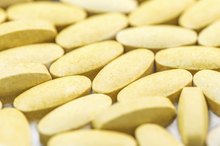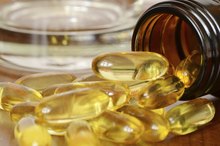What does fact checked mean?
At Healthfully, we strive to deliver objective content that is accurate and up-to-date. Our team periodically reviews articles in order to ensure content quality. The sources cited below consist of evidence from peer-reviewed journals, prominent medical organizations, academic associations, and government data.
- MayoClinic.com; Yeast infection; May 2010
- National Institutes of Health Office of Dietary Supplements: Vitamin C
The information contained on this site is for informational purposes only, and should not be used as a substitute for the advice of a professional health care provider. Please check with the appropriate physician regarding health questions and concerns. Although we strive to deliver accurate and up-to-date information, no guarantee to that effect is made.
Vitamin C & Yeast Infection
Vaginal yeast infections affect the majority of women at some point, and although they are not typically associated with greater harms to your health, they can produce significant discomfort. Vitamin C may help to relieve symptoms of yeast infections and facilitate healing. However, as of 2011, more research is needed to understand whether and how vitamin C supports the healthy ecology of vaginal bacteria. While there are no known health risks associated with dietary vitamin C, high levels of supplements may adversely affect your health 2. Prior to taking a vitamin C supplement, consult your doctor to discuss your personal health needs.
If you are experiencing serious medical symptoms, seek emergency treatment immediately.
Yeast Infections
Vaginal yeast infections affect approximately three out of four women at some point in their lives, and many women experience multiple infections. Vaginal yeast infections are a type of vaginitis, a condition in which the vagina becomes irritated and inflamed. Infections range from mild to severe and are characterized by symptoms of itching, burning, possible odor and a thick, milky discharge. The fungus, candida albicans, is responsible for the majority of vaginal yeast infections, and overgrowth disrupts the balance of healthy bacteria in your vagina.
- Vaginal yeast infections affect approximately three out of four women at some point in their lives, and many women experience multiple infections.
Standard Treatments
Vitamin C Treatment for Bacterial Vaginosis
Learn More
The appropriate treatment for a vaginal yeast infection depends on the severity of the condition. If you have a severe or chronic infection, your doctor may advise a longer course of vaginal therapy or multiple doses of an oral antifungal medication. If you are sexually active, vaginal intercourse can further complicate your infection, and your doctor may advise using condoms or possible treatment for your partner.
Vitamin C
An essential nutrient and antioxidant, vitamin C plays a central role in wound healing and immune function, and research suggests that it may help to prevent or delay cardiovascular disease and certain cancers. As a nutrient required for the function of your immune system, vitamin C may help to facilitate recovery from a yeast infection 1. However, as of 2011, there is not substantial research on the effects of vitamin C in either dietary or supplemental form for treating or preventing the condition. According to the University of Maryland Medical Center, dietary supplements of vitamin C may serve to reduce symptoms of inflammation associated with yeast infections 23.
Related Research
Acidophilus & Folic Acid for Bacterial Vaginosis
Learn More
While scientific research has not documented the efficacy of vitamin C for treating yeast infections, recent studies indicate that it may be useful in curing vaginitis. Peterson et al. ; November 2004').
Related Articles
References
- MayoClinic.com; Yeast infection; May 2010
- National Institutes of Health Office of Dietary Supplements: Vitamin C
- University of Maryland Medical Center: Candidiasis
- "European Journal of Obstetrics, Gynecology and Reproductive Biology"; Efficacy and Safety of Vitamin C Vaginal Tablets in the Treatment of Non-Specific Vaginitis; E.E. Peterson et al.; November 2004
- Martin Lopez JE. Candidiasis (vulvovaginal. BMJ Clin Evid. 2015 Mar 16;2015:0815
- National Center for Biotechnology Information. Vaginal candidiasis (vulvovaginal candidiasis). Updated February 24, 2019.
- Sobel JD. Patient education: Vaginal yeast infection (beyond the basics). UpToDate, Inc. Updated February 7, 2019.
- Zomorodian K, Kavoosi F, Pishdad GR, et al. Prevalence of oral Candida colonization in patients with diabetes mellitus. J Mycol Med. 2016;26(2):103-110. doi:10.1016/j.mycmed.2015.12.008
- Moshfeghy Z, Tahari S, Janghorban, et al. Association of sexual function and psychological symptoms including depression, anxiety and stress in women with recurrent vulvovaginal candidiasis. J Turk Ger Gynecol Assoc. 2020 Jun; 21(2): 90–96. doi:10.4274/jtgga.galenos.2019.2019.0077
- Brunham RC, Gottlieb SL, Paavonen J. Pelvic inflammatory disease. N Engl J Med. 2015;372(21):2039-48. doi:10.1056/NEJMra1411426
- Zhu Y, Bateman BT, Gray KJ, et al. Oral fluconazole use in the first trimester and risk of congenital malformations: Population based cohort study. BMJ. 2020; 369: m1494.doi:10.1136/bmj.m1494
- Behmanesh F, Pasha H, Sefidgar AA, et al. Antifungal effect of lavender essential oil (Lavandula angustifolia) And clotrimazole on candida albicans: An in vitro study. Scientifica (Cairo). 2015;2015:261397. doi:10.1155/2015/261397
- Mertas A, Garbusinska A, Szliszka, E, et al. The influence of tea tree oil (Melaleuca alternifolia) On fluconazole activity against fluconazole-resistant candida albicans strains. Biomed Res Int. 2015; 2015: 590470. doi:10.1155/2015/590470
- Ferris DG, Nyirjesy P, Sobel JD, et al. Over-the-counter antifungal drug misuse associated with patient-diagnosed vulvovaginal candidiasis. Obstet Gynecol. 2002 Mar;99(3):419-25. doi:10.1016/s0029-7844(01)01759-8
- Department of Health & Human Services. Office on Women's Health. Vaginal yeast infections. Apr 1, 2019.
- Iavazzo C, Gkegkes ID, Zarkada IM, Falagas ME. Boric acid for recurrent vulvovaginal candidiasis: the clinical evidence. J Womens Health (Larchmt). 2011;20(8):1245-55.
- Rane HS, Bernardo SM, Howell AB, et al. Cranberry-derived proanthocyanidins prevent formation of Candida albicans biofilms in artificial urine through biofilm- and adherence-specific mechanisms. J Antimicrob Chemother. 2014 Feb;69(2):428-36. doi:10.1093/jac/dkt398
- Williams A. Yogurt: Still a favorite for vaginal candidiasis?. J Natl Med Assoc. 2002;94(4):A10.
- Gonçalves B, Ferreira C, Alves CT, et al. Vulvovaginal candidiasis: Epidemiology, microbiology and risk factors. Crit Rev Microbiol. 2016 Nov;42(6):905-27. doi:10.3109/1040841X.2015.1091805
- Hanson L, Vandevusse L, Jermé M, et al. Probiotics for treatment and prevention of urogenital infections in women: A systematic review. Journal of Midwifery & Womens Health. 2016;61(3):339-355. doi:10.1111/jmwh.12472
- Mendling W. Guideline: Vulvovaginal candidosis (AWMF 015/072), S2k (excluding chronic mucocutaneous candidosis). Mycoses. 2015;58:1-15. doi:10.1111/myc.12292
- Office on Women's Health. Vaginal yeast infections. Apr 1, 2019.
Writer Bio
Helen Anderson has been writing and editing professionally since 2007. Her work has appeared in scholarly and popular publications, such as "Foreign Affairs" and "The New York Times." Anderson holds a master's degree in public health from Columbia University, where she is currently completing a Ph.D.









